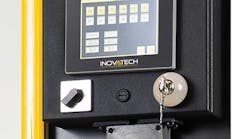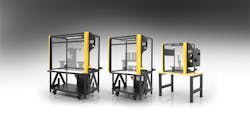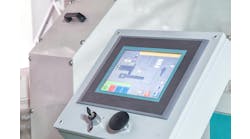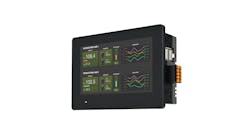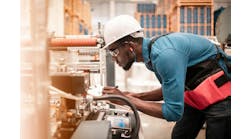Time is money, so taking less time to design, program and integrate a system is money in the bank. Inovatech Automation in Macomb, Michigan, understands this as well as any machine builder does, and it shows in the well-thought-out machines it designs and builds. Both the mechanical design and manufacturing and the control design and programming sides are creating better and more efficient ways to design, build, install and program automated machinery.
"In our business, everything is based off of time—how long it takes to program something," says Travis Buset, director of operations at Inovatech Automation. "It's based on hours; hours mean dollars. The same is true for how long it takes to design and build the machines."
Inovatech is known for its Modular Automation Station System (MASS). Available in several sizes, from tabletop to a large free-standing work cell, these systems are expandable and customizable, with easy-to-change tooling. There is also a robot version available in which Inovatech can integrate a wide variety of robots, depending on customer needs and specifications (Figure 1).
Figure 1: Inovatech Automation's MASS machines are available in several sizes and are easy to expand and customize.
(Source: Inovatech Automation)
About a machine builder
In business since May 2016, Inovatech is an automation company that makes modular systems. "Our first way of thinking when we build a piece of equipment is for it to last a long time," says Buset. "We don't just want to design the machine to run a single product—that will go obsolete. When we build a piece of equipment, we build it to be modular with replaceable components and fixtures (Figure 2)."
Figure 2: Equipment is built to be modular, with replaceable components and fixtures.
(Source: Inovatech Automation)
It also is good at improving the efficiency of packaging, such as taking parts, putting them in a box and sending them out the door, as well as reducing the cost relative to manpower. While it doesn't make the OEM packaging equipment to erect the box, it integrates the equipment, adding robots, conveyors and other handling equipment, such as robot end-of-arm tooling (EOAT) for a turnkey solution.
Faster programming
Another way Inovatech saves time is in programming. "I like Pro-face's ease of programming," says Buset. "The software—the HMI and PLC—is all in one, HMI plus control. What took me eight hours with the competitor’s PLC usually only takes me half the time and sometimes only a quarter of the time using Pro-face."
The all-in-one program from Pro-face America, GP-Pro EX, makes programming quick and easy, continues Buset. "Some of the competitors out there have separate PLC and HMI programming software—it's separate programs," he says. "The GP-Pro EX software allows programming of the CPU/controller and the HMI all in one."
Much of the addressing is drag-and-drop, which reduces programming time. "For example, if separate software is used to program a button to turn something on, the controller software is used to add the logic and addressing," says Buset. "Then the HMI software would be opened, the button would be programmed and addressing checked. On the other hand, the GP-Pro EX software allows a normally open contact in the logic section of the program to be dragged and dropped into the HMI graphics. Selection of a button, style of the button and automatic addresses seamlessly follow all-in-one operation. It makes programming a lot easier and quicker."
The GP-Pro EX software combines the HMI and logic development software in a single platform. It's a PLC and HMI all in one and with I/O expansion and more than 125 logic instructions. Inovatech often uses the Pro-face PFXLM4301TADDC HMI + Control with 20 inputs and 12 outputs, built-in. To expand the I/O, it uses CANopen.
The Pro-face tools are very powerful, says Buset. "I actually built a system with one PLC/HMI unit and it ran two Universal Robots robot arms, eight conveyors and four different IO-Link networks," he says. "It's very powerful. Why spend $3,000 on an HMI and a PLC when I can spend less than $1,000, and it does the exact same thing?”
The software platform is in the $300 range, and the tech support is free, says Buset. "I had technical questions, especially when I started out," he explains. "Although I learned the bulk of it on my own with the help of YouTube, when I started to get into addressing and integrating the Pro-face, I had a lot of questions. Tech support was able to answer them very quickly."
See and control
Much of Inovatech's work is in the automotive and medical industries, which uses a wide variety of automated machines. "The Pro-face is my interface to all our machines," says Buset. "Whether I connect to a Universal Robot, a bowl feeder, a conveyor or a camera, it all gets funneled through the Pro-face unit. It also has a wide range of communication capabilities using, for example, EtherNet/IP to connect to Cognex and Dalsa cameras in vision applications (Figure 3)."
Figure 3: A wide range of communication capabilities are available—for example, EtherNet/IP to connect to Cognex and Dalsa cameras.
(Source: Inovatech Automation)
Inovatech integrates a lot of robot arms from Universal Robots (UR). "The Pro-face integrates well with UR with up to two robots connected to one Pro-face unit," says Buset. "It's done all through Ethernet. One wire, one click, and it works well. We also use IO-Link."
Inovatech uses ladder logic, function blocks and scripting in the Pro-face for controlling a machine sequence, interfacing to cameras and robots, and handling data. All the I/O is connected through the Pro-face.
Buset describes an example application where a machine is installing thermal inserts. "The Pro-face helps the operator to operate the machine with access to functions such as cycle control and machine functions,” he explains. “Under a normal sequence, the machine may install 14 inserts. Through a password-protected operator-interface screen, a graphic of the part can be displayed, allowing the operator to select or deselect positions, so only 10 inserts, for example, are installed, simplifying machine configuration. Similarly, recipes can also be programmed."
The Pro-face solution has many built-in function blocks. A few examples included talking to a camera or robot. Inovatech also programs its own function blocks depending on what it is interfacing to.
HMI screens and graphics
Inovatech considers pushbuttons and alarming two of the big uses for an HMI. "Letting the operator know something is wrong is one of the most basic requirements," says Buset. "Displaying part counts, such as good and reject, is also common."
Pretty pictures, as Buset likes to call the graphics, is another big use of an HMI. "Machine and sensor status are an important part of this, and Invotech monitors all its sensors," he says. "If a fixture has multiple cylinders on it, lights are included on the HMI for ease of troubleshooting. If a sensor is intermittent or someone moved the sensor, the graphics helps inform the operator. The user can actually see a graphical representation of the cylinder and the actual sensor position, making troubleshooting much easier."
Secrets to success
“When I started the business, I did it all,” says Buset. "I was the designer; I was the controls engineer; I did all the wiring; I did all the PLC programming; everything."
He even still cleans the bathrooms, when needed. As a matter of fact, if you come to Buset's shop, it is very clean. "I get compliments on the cleanliness," says Buset. "A customer was in the other day, and the first thing he commented on was how clean and organized the shop was. That's good, considering I thought it was messy at the time."
Previously, Buset had worked at an injection-molding company, building all of the machines in-house. The company didn't have to outsource any machines. That certainly made him qualified for injection-molding automation and machine-tending applications. He's also a RJG-certified master molder, so he can also process the molding machines.
It's one of the customer benefits when Buset visits. If the injection-molding machine needs to be automated, he can automate it. Even with minimal customer input and guidance, Inovatech can provide a turnkey project. And, of course, customers with 30-page spec sheets are well served, as well.
For the customers who don't have a spec sheet, Inovatech can create one. "It's the default design, if needed," says Buset. "It includes a Pro-face HMI + Control, which is its standard PLC, as well as standard relay, circuit breakers and related control hardware. We can also create a spec sheet specifically for a customer."
Put a robot on it
The Pro-face solution is actually used to change robot pick-and-place points, instead of using the robot pendant. "The HMI provides access to simple points used to place an insert," says Buset. "So, if we need to insert it further, the Pro-face can send the set point data to the robot. If an insert is being placed, the robot moves down to the insertion point until it sees a force using a six-axis force sensor integrated into the robot end effector. The position of the force is recorded, and then the robot moves down an addition 3 mm, for example. This technique drives the insert to a flush or below-flush position, depending on what the specifications require."
The robot moves are programmed on the robot, but, through the HMI, the positions can be edited or offset, continues Buset. "That way, if adjustments are needed, such as a depth of only 2.5 mm, the operator can make a simple adjustment through the HMI and not have to deal with the robot pendant," he says. "It's mostly limited to linear moves, moving to a position, not j-type moves, such as x-y-z and rotations."
